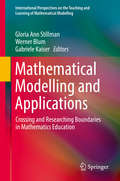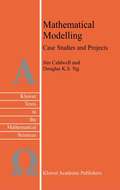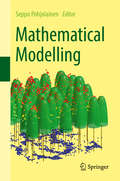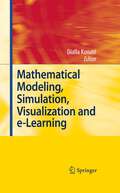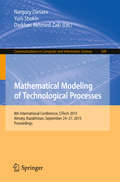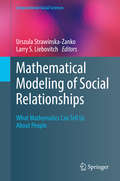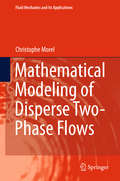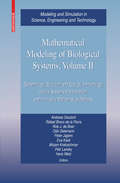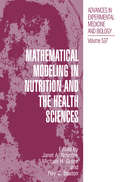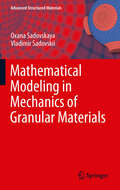- Table View
- List View
Mathematical Modelling and Applications: Crossing and Researching Boundaries in Mathematics Education (International Perspectives on the Teaching and Learning of Mathematical Modelling)
by Gloria Ann Stillman Werner Blum Gabriele KaiserThis volume documents on-going research and theorising in the sub-field of mathematics education devoted to the teaching and learning of mathematical modelling and applications. Mathematical modelling provides a way of conceiving and resolving problems in the life world of people whether these range from the everyday individual numeracy level to sophisticated new problems for society at large. Mathematical modelling and real world applications are considered as having potential for multi-disciplinary work that involves knowledge from a variety of communities of practice such as those in different workplaces (e.g., those of educators, designers, construction engineers, museum curators) and in different fields of academic endeavour (e.g., history, archaeology, mathematics, economics). From an educational perspective, researching the development of competency in real world modelling involves research situated in crossing the boundaries between being a student engaged in modelling or mathematical application to real word tasks in the classroom, being a teacher of mathematical modelling (in or outside the classroom or bridging both), and being a modeller of the world outside the classroom. This is the focus of many of the authors of the chapters in this book. All authors of this volume are members of the International Community of Teachers of Mathematical Modelling (ICTMA), the peak research body into researching the teaching and learning of mathematical modelling at all levels of education from the early years to tertiary education as well as in the workplace.
Mathematical Modelling: Case Studies and Projects (Texts in the Mathematical Sciences #28)
by J. Caldwell Douglas K.S. NgOver the past decade there has been an increasing demand for suitable material in the area of mathematical modelling as applied to science, engineering, business and management. Recent developments in computer technology and related software have provided the necessary tools of increasing power and sophistication which have significant implications for the use and role of mathematical modelling in the above disciplines. In the past, traditional methods have relied heavily on expensive experimentation and the building of scaled models, but now a more flexible and cost effective approach is available through greater use of mathematical modelling and computer simulation. In particular, developments in computer algebra, symbolic manipulation packages and user friendly software packages for large scale problems, all have important implications in both the teaching of mathematical modelling and, more importantly, its use in the solution of real world problems. Many textbooks have been published which cover the art and techniques of modelling as well as specific mathematical modelling techniques in specialist areas within science and business. In most of these books the mathematical material tends to be rather tailor made to fit in with a one or two semester course for teaching students at the undergraduate or postgraduate level, usually the former. This textbook is quite different in that it is intended to build on and enhance students’ modelling skills using a combination of case studies and projects.
Mathematical Modelling
by Matti Heiliö Timo Lähivaara Erkki Laitinen Timo Mantere Jorma Merikoski Seppo Pohjolainen Kimmo Raivio Risto Silvennoinen Antti Suutala Tanja Tarvainen Timo Tiihonen Jukka Tuomela Esko Turunen Marko VauhkonenThis book provides a thorough introduction to the challenge of applying mathematics in real-world scenarios. Modelling tasks rarely involve well-defined categories, and they often require multidisciplinary input from mathematics, physics, computer sciences, or engineering. In keeping with this spirit of modelling, the book includes a wealth of cross-references between the chapters and frequently points to the real-world context.The book combines classical approaches to modelling with novel areas such as soft computing methods, inverse problems, and model uncertainty. Attention is also paid to the interaction between models, data and the use of mathematical software. The reader will find a broad selection of theoretical tools for practicing industrial mathematics, including the analysis of continuum models, probabilistic and discrete phenomena, and asymptotic and sensitivity analysis.
Mathematical Modeling, Simulation, Visualization and e-Learning: Proceedings of an International Workshop held at Rockefeller Foundation' s Bellagio Conference Center, Milan, Italy, 2006
by Dialla KonatéThis book features articles written by some of the most prominent leading applied mathematicians as well as young and promising ones. The common objective of these articles is to present an important issue which is currently widely discussed in scientific investigation with major human, economic or ecological implications. Each article is as deep as an expert lecture but is also self-contained, so that even isolated scientists with limited resources can profit greatly from it.
Mathematical Modeling of Technological Processes: 8th International Conference, CITech 2015, Almaty, Kazakhstan, September 24-27, 2015, Proceedings (Communications in Computer and Information Science #549)
by Nargozy Danaev Yurii Shokin Akhmed-Zaki DarkhanThis book constitutes the refereed proceedings of the Mathematical modeling of technological processes track of the 8th International Conference on Computational and Information Technologies in Science, Engineering and Education, CITech 2015, held in Almaty, Kazakhstan, in September 2015. The 20 papers and one short paper presented were carefully reviewed and selected from 56 submissions to the track. They provide a forum for sharing new aspects of the progresses in the areas of mathematical modeling of technological processes; process automation and control; high performance computing; simulation.
Mathematical Modeling of Social Relationships: What Mathematics Can Tell Us About People (Computational Social Sciences)
by Urszula Strawinska-Zanko Larry S. LiebovitchThis edited volume presents examples of social science research projects that employ new methods of quantitative analysis and mathematical modeling of social processes. This book presents the fascinating areas of empirical and theoretical investigations that use formal mathematics in a way that is accessible for individuals lacking extensive expertise but still desiring to expand their scope of research methodology and add to their data analysis toolbox. Mathematical Modeling of Social Relationships professes how mathematical modeling can help us understand the fundamental, compelling, and yet sometimes complicated concepts that arise in the social sciences. This volume will appeal to upper-level students and researchers in a broad area of fields within the social sciences, as well as the disciplines of social psychology, complex systems, and applied mathematics.
Mathematical Modeling of Disperse Two-Phase Flows (Fluid Mechanics and Its Applications #114)
by Christophe MorelThis book develops the theoretical foundations of disperse two-phase flows, which are characterized by the existence of bubbles, droplets or solid particles finely dispersed in a carrier fluid, which can be a liquid or a gas. Chapters clarify many difficult subjects, including modeling of the interfacial area concentration. Basic knowledge of the subjects treated in this book is essential to practitioners of Computational Fluid Dynamics for two-phase flows in a variety of industrial and environmental settings.The author provides a complete derivation of the basic equations, followed by more advanced subjects like turbulence equations for the two phases (continuous and disperse) and multi-size particulate flow modeling. As well as theoretical material, readers will discover chapters concerned with closure relations and numerical issues. Many physical models are presented, covering key subjects including heat and mass transfers between phases, interfacial forces and fluid particles coalescence and breakup, amongst others.This book is highly suitable for students in the subject area, but may also be a useful reference text for more advanced scientists and engineers.
Mathematical Modeling of Biological Systems, Volume II: Epidemiology, Evolution and Ecology, Immunology, Neural Systems and the Brain, and Innovative Mathematical Methods (Modeling and Simulation in Science, Engineering and Technology)
by Hans Metz Andreas Deutsch Rafael Bravo De La Parra Rob J. De Boer Odo Diekmann Peter Jagers Eva Kisdi Mirjam Kretzschmar Petr LanskyVolume II of this two-volume, interdisciplinary work is a unified presentation of a broad range of state-of-the-art topics in the rapidly growing field of mathematical modeling in the biological sciences. Highlighted throughout are mathematical and computational apporaches to examine central problems in the life sciences, ranging from the organization principles of individual cells to the dynamics of large populations. The chapters are thematically organized into the following main areas: epidemiology, evolution and ecology, immunology, neural systems and the brain, and innovative mathematical methods and education. The work will be an excellent reference text for a broad audience of researchers, practitioners, and advanced students in this rapidly growing field at the intersection of applied mathematics, experimental biology and medicine, computational biology, biochemistry, computer science, and physics.
Mathematical Modeling in Nutrition and the Health Sciences (Advances in Experimental Medicine and Biology #537)
by Janet A. Novotny Michael H. Green Ray C. BostonMathematical Modeling in Mechanics of Granular Materials (Advanced Structured Materials #21)
by Oxana Sadovskaya Vladimir SadovskiiThis monograph contains original results in the field of mathematical and numerical modeling of mechanical behavior of granular materials and materials with different strengths. It proposes new models helping to define zones of the strain localization. The book shows how to analyze processes of the propagation of elastic and elastic-plastic waves in loosened materials, and constructs models of mixed type, describing the flow of granular materials in the presence of quasi-static deformation zones. In a last part, the book studies a numerical realization of the models on multiprocessor computer systems. The book is intended for scientific researchers, lecturers of universities, post-graduates and senior students, who specialize in the field of the deformable materials mechanics, mathematical modeling and adjacent fields of applied and calculus mathematics.
Mathematical Modeling for Intelligent Systems: Theory, Methods, and Simulation
by Mukesh Kumar AwasthiMathematical Modeling for Intelligent Systems: Theory, Methods, and Simulation aims to provide a reference for the applications of mathematical modeling using intelligent techniques in various unique industry problems in the era of Industry 4.0. Providing a thorough introduction to the field of soft-computing techniques, this book covers every major technique in artificial intelligence in a clear and practical style. It also highlights current research and applications, addresses issues encountered in the development of applied systems, and describes a wide range of intelligent systems techniques, including neural networks, fuzzy logic, evolutionary strategy, and genetic algorithms. This book demonstrates concepts through simulation examples and practical experimental results. Key Features: • Offers a well-balanced mathematical analysis of modeling physical systems • Summarizes basic principles in differential geometry and convex analysis as needed • Covers a wide range of industrial and social applications and bridges the gap between core theory and costly experiments through simulations and modeling • Focuses on manifold ranging from stability of fluid flows, nanofluids, drug delivery, and security of image data to pandemic modeling, etc. This book is primarily aimed at advanced undergraduates and postgraduate students studying computer science, mathematics, and statistics. Researchers and professionals will also find this book useful.
Mathematical Modeling for Intelligent Systems: Theory, Methods, and Simulation
by Mukesh Kumar Awasthi Ravi Tomar Maanak GuptaMathematical Modeling for Intelligent Systems: Theory, Methods, and Simulation aims to provide a reference for the applications of mathematical modeling using intelligent techniques in various unique industry problems in the era of Industry 4.0. Providing a thorough introduction to the field of soft-computing techniques, this book covers every major technique in artificial intelligence in a clear and practical style. It also highlights current research and applications, addresses issues encountered in the development of applied systems, and describes a wide range of intelligent systems techniques, including neural networks, fuzzy logic, evolutionary strategy, and genetic algorithms. This book demonstrates concepts through simulation examples and practical experimental results. Key Features: • Offers a well-balanced mathematical analysis of modeling physical systems • Summarizes basic principles in differential geometry and convex analysis as needed • Covers a wide range of industrial and social applications and bridges the gap between core theory and costly experiments through simulations and modeling • Focuses on manifold ranging from stability of fluid flows, nanofluids, drug delivery, and security of image data to pandemic modeling, etc. This book is primarily aimed at advanced undergraduates and postgraduate students studying computer science, mathematics, and statistics. Researchers and professionals will also find this book useful.
Mathematical Modeling for Genes to Collective Cell Dynamics (Theoretical Biology)
by Tetsuji TokihiroThis book describes the dynamics of biological cells and their mathematical modeling. The topics cover the dynamics of RNA polymerases in transcription, construction of vascular networks in angiogenesis, and synchronization of cardiomyocytes. Statistical analysis of single cell dynamics and classification of proteins by mathematical modeling are also presented. The book provides the most up-to-date information on both experimental results and mathematical models that can be used to analyze cellular dynamics. Novel experimental results and approaches to understand them will be appealing to the readers. Each chapter contains 1) an introductory description of the phenomenon, 2) explanations about the mathematical technique to analyze it, 3) new experimental results, 4) mathematical modeling and its application to the phenomenon. Elementary introductions for the biological phenomenon and mathematical approach to them are especially useful for beginners. The importance of collaboration between mathematics and biological sciences has been increasing and providing new outcomes. This book gives good examples of the fruitful collaboration between mathematics and biological sciences.
Mathematical Modeling for Complex Fluids and Flows
by Michel Deville Thomas B. GatskiMathematical Modeling for Complex Fluids and Flows provides researchers and engineering practitioners encountering fluid flows with state-of-the-art knowledge in continuum concepts and associated fluid dynamics. In doing so it supplies the means to design mathematical models of these flows that adequately express the engineering physics involved. It exploits the implicit link between the turbulent flow of classical Newtonian fluids and the laminar and turbulent flow of non-Newtonian fluids such as those required in food processing and polymeric flows.The book develops a descriptive mathematical model articulated through continuum mechanics concepts for these non-Newtonian, viscoelastic fluids and turbulent flows. Each complex fluid and flow is examined in this continuum context as well as in combination with the turbulent flow of viscoelastic fluids. Some details are also explored via kinetic theory, especially viscoelastic fluids and their treatment with the Boltzmann equation. Both solution and modeling strategies for turbulent flows are laid out using continuum concepts, including a description of constructing polynomial representations and accounting for non-inertial and curvature effects.Ranging from fundamental concepts to practical methodology, and including discussion of emerging technologies, this book is ideal for those requiring a single-source assessment of current practice in this intricate yet vital field.
Mathematical Modeling, Computational Intelligence Techniques and Renewable Energy: Proceedings of the Third International Conference, MMCITRE 2022 (Advances in Intelligent Systems and Computing #1440)
by Manoj Sahni José M. Merigó Walayat Hussain Ernesto León-Castro Raj Kumar Verma Ritu SahniThe book is a collection of best selected research papers presented at the Third International Conference on “Mathematical Modeling, Computational Intelligence Techniques and Renewable Energy (MMCITRE 2022),” organized by the University of Technology Sydney, Australia, in association with the Department of Mathematics, Pandit Deendayal Energy University, India, and Forum for Interdisciplinary Mathematics. This book presents new knowledge and recent developments in all aspects of computational techniques, mathematical modeling, energy systems, applications of fuzzy sets and intelligent computing. The book provides innovative works of researchers, academicians and students in the area of interdisciplinary mathematics, statistics, computational intelligence and renewable energy.
Mathematical Modeling, Computational Intelligence Techniques and Renewable Energy: Proceedings of the First International Conference, MMCITRE 2020 (Advances in Intelligent Systems and Computing #1287)
by Manoj Sahni José M. Merigó Brajesh Kumar Jha Rajkumar VermaThis book presents new knowledge and recent developments in all aspects of computational techniques, mathematical modeling, energy systems, applications of fuzzy sets and intelligent computing. The book is a collection of best selected research papers presented at the International Conference on “Mathematical Modeling, Computational Intelligence Techniques and Renewable Energy,” organized by the Department of Mathematics, Pandit Deendayal Petroleum University, in association with Forum for Interdisciplinary Mathematics, Institution of Engineers (IEI) – Gujarat and Computer Society of India (CSI) – Ahmedabad. The book provides innovative works of researchers, academicians and students in the area of interdisciplinary mathematics, statistics, computational intelligence and renewable energy.
Mathematical Modeling, Computational Intelligence Techniques and Renewable Energy: Proceedings of the Second International Conference, MMCITRE 2021 (Advances in Intelligent Systems and Computing #1405)
by Manoj Sahni José M. Merigó Ritu Sahni Rajkumar VermaThis book presents new knowledge and recent developments in all aspects of computational techniques, mathematical modeling, energy systems, and applications of fuzzy sets and intelligent computing. The book is a collection of best selected research papers presented at the Second International Conference on “Mathematical Modeling, Computational Intelligence Techniques and Renewable Energy (MMCITRE 2021),” organized by the Department of Mathematics, Pandit Deendayal Petroleum University, in association with Forum for Interdisciplinary Mathematics. The book provides innovative works of researchers, academicians, and students in the area of interdisciplinary mathematics, statistics, computational intelligence, and renewable energy.
Mathematical Modeling and Supercomputer Technologies: 20th International Conference, MMST 2020, Nizhny Novgorod, Russia, November 23 – 27, 2020, Revised Selected Papers (Communications in Computer and Information Science #1413)
by Dmitry Balandin Konstantin Barkalov Victor Gergel Iosif MeyerovThis book constitutes selected and revised papers from the 20th International Conference on Mathematical Modeling and Supercomputer Technologies, MMST 2020, held in Nizhny Novgorod, Russia, in November 2020. Due to the COVID-19 pandemic the conference was held online. The 25 full papers and 8 short papers presented in the volume were thoroughly reviewed and selected from the 106 submissions. They are organized in topical secions on computational methods for mathematical models analysis; computation in optimization and optimal control; supercomputer simulation.
Mathematical Modeling and Supercomputer Technologies: 22nd International Conference, MMST 2022, Nizhny Novgorod, Russia, November 14–17, 2022, Revised Selected Papers (Communications in Computer and Information Science #1750)
by Dmitry Balandin Konstantin Barkalov Iosif MeyerovThis book constitutes selected and revised papers from the 22nd International Conference on Mathematical Modeling and Supercomputer Technologies, MMST 2022, held in Nizhny Novgorod, Russia, in November 2022. The 20 full papers and 5 short papers presented in the volume were thoroughly reviewed and selected from the 48 submissions. They are organized in topical secions on computational methods for mathematical models analysis; computation in optimization and optimal control; supercomputer simulation.
Mathematical Modeling and Supercomputer Technologies: 23rd International Conference, MMST 2023, Nizhny Novgorod, Russia, November 13–16, 2023, Revised Selected Papers (Communications in Computer and Information Science #1914)
by Dmitry Balandin Konstantin Barkalov Iosif MeyerovThis book constitutes selected and revised papers from the 23rd International Conference on Mathematical Modeling and Supercomputer Technologies, MMST 2023, held in Nizhny Novgorod, Russia, during November 13–16 2023. The 18 full papers and 7 short papers presented in the volume were thoroughly reviewed and selected from the 45 submissions. They are organized in topical sections as follows: computational methods for mathematical models analysis; computation in optimization and optimal control; artificial intelligence and supercomputer simulation.
Mathematical Modeling and Simulation of Systems: Selected Papers of 14th International Scientific-Practical Conference, MODS, 2019 June 24-26, Chernihiv, Ukraine (Advances in Intelligent Systems and Computing #1019)
by Alexander Palagin Anatoliy Anisimov Anatoliy Morozov Serhiy ShkarletThis book presents current investigations in the field of mathematical modeling and simulation to support the development of intelligent information systems in domains such as ecology and geology, manufacturing, project management, and safety of distributed information systems. The book will be of interest to developers of modern high-tech software complexes for situational control centers, based on mathematical modeling and simulation methods. In addition, it will appeal to software engineers and programmers, offering them new implementation and application methods. Gathering the latest research, prepared by leading scholars, and identifying promising new directions for solving complex scientific and practical problems, the book presents selected outcomes of the 14th International Scientific-Practical Conference, MODS2019, held in Chernihiv, Ukraine, on June 24 to 26, 2019.
Mathematical Modeling and Simulation of Systems: Selected Papers of 15th International Scientific-practical Conference, MODS, 2020 June 29 – July 01, Chernihiv, Ukraine (Advances in Intelligent Systems and Computing #1265)
by Serhiy Shkarlet Anatoliy Morozov Alexander PalaginThis book contains works on mathematical and simulation modeling of processes in various domains: ecology and geographic information systems, IT, industry, and project management. The development of complex multicomponent systems requires an increase in accuracy, efficiency, and adequacy while reducing the cost of their creation.The studies presented in the book are useful to specialists who are involved in the development of real events models: analog, management and decision-making models, production models, and software products. Scientists can get acquainted with the latest research in various decisions proposed by leading scholars and identify promising directions for solving complex scientific and practical problems. The chapters of this book contain the contributions presented on the 15th International Scientific-Practical Conference, MODS, June 29–July 01, 2020, Chernihiv, Ukraine.
Mathematical Modeling and Signal Processing in Speech and Hearing Sciences (MS&A #10)
by Jack Xin Yingyong QiThe aim of the book is to give an accessible introduction of mathematical models and signal processing methods in speech and hearing sciences for senior undergraduate and beginning graduate students with basic knowledge of linear algebra, differential equations, numerical analysis, and probability. Speech and hearing sciences are fundamental to numerous technological advances of the digital world in the past decade, from music compression in MP3 to digital hearing aids, from network based voice enabled services to speech interaction with mobile phones. Mathematics and computation are intimately related to these leaps and bounds. On the other hand, speech and hearing are strongly interdisciplinary areas where dissimilar scientific and engineering publications and approaches often coexist and make it difficult for newcomers to enter.
Mathematical Modeling and Optimization of Complex Structures (Computational Methods in Applied Sciences #40)
by Pekka Neittaanmäki Sergey Repin Tero TuovinenThis volume contains selected papers in three closely related areas: mathematical modeling in mechanics, numerical analysis, and optimization methods. The papers are based upon talks presented on the International Conference for Mathematical Modeling and Optimization in Mechanics, held in Jyväskylä, Finland, March 6-7, 2014 dedicated to Prof. N. Banichuk on the occasion of his 70th birthday. The articles are written by well-known scientists working in computational mechanics and in optimization of complicated technical models. Also, the volume contains papers discussing the historical development, the state of the art, new ideas, and open problems arising in modern continuum mechanics and applied optimization problems. Several papers are concerned with mathematical problems in numerical analysis, which are also closely related to important mechanical models. The main topics treated include: * Computer simulation methods in mechanics, physics, and biology;* Variational problems and methods; minimization algorithms;* Optimal control problems with distributed and discrete control;* Shape optimization and shape design problems in science and engineering;* Sensitivity analysis and parameters optimization of complex systems.
Mathematical Modeling and Numerical Simulation in Continuum Mechanics: Proceedings of the International Symposium on Mathematical Modeling and Numerical Simulation in Continuum Mechanics, September 29 – October 3, 2000 Yamaguchi, Japan (Lecture Notes in Computational Science and Engineering #19)
by Ivo Babuska Philippe G. Ciarlet Tetsuhiko MiyoshiThe first international symposium on mathematical foundations of the finite element method was held at the University of Maryland in 1973. During the last three decades there has been great progress in the theory and practice of solving partial differential equations, and research has extended in various directions. Full-scale nonlinear problems have come within the range of nu merical simulation. The importance of mathematical modeling and analysis in science and engineering is steadily increasing. In addition, new possibili ties of analysing the reliability of computations have appeared. Many other developments have occurred: these are only the most noteworthy. This book is the record of the proceedings of the International Sympo sium on Mathematical Modeling and Numerical Simulation in Continuum Mechanics, held in Yamaguchi, Japan from 29 September to 3 October 2000. The topics covered by the symposium ranged from solids to fluids, and in cluded both mathematical and computational analysis of phenomena and algorithms. Twenty-one invited talks were delivered at the symposium. This volume includes almost all of them, and expresses aspects of the progress mentioned above. All the papers were individually refereed. We hope that this volume will be a stepping-stone for further developments in this field.
